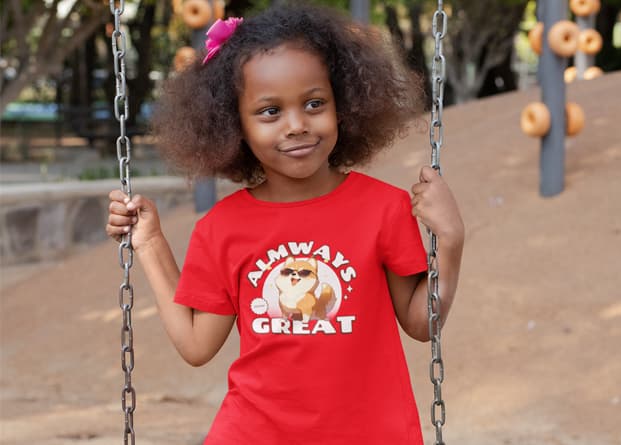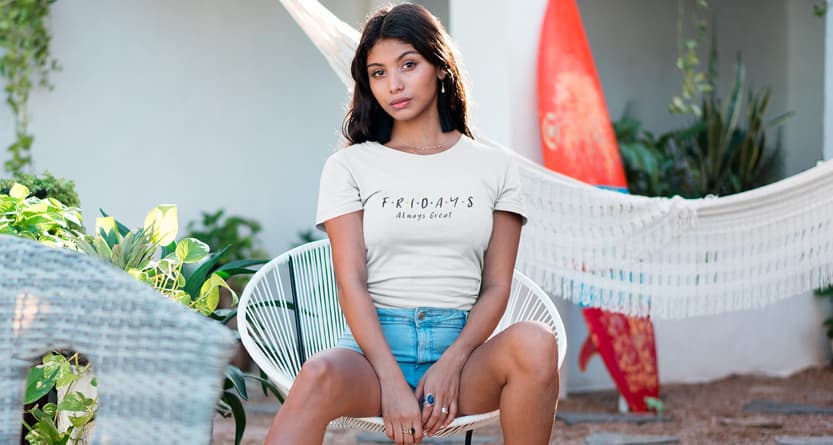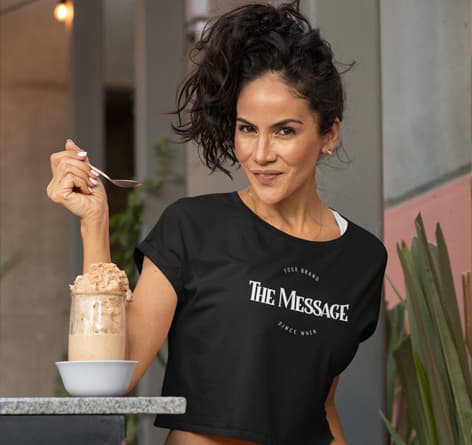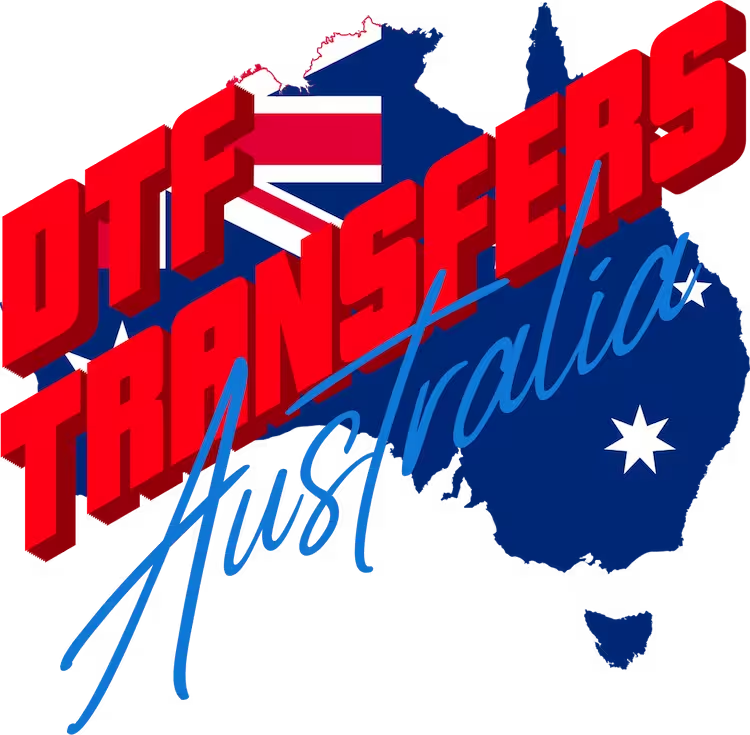All Posts, Start a T-Shirt Business
Boost Your Prints: Essential T-Shirt Design Tips
T-Shirt Design Tips can make the difference between a good design and an outstanding one.
Indeed, for anyone who’s tried their hand at designing t-shirts, they know it’s not as simple as slapping on some text or graphics together.
Mastery of elements like typography, colour choices and composition separates the amateurs from the pros in t-shirt design. But let’s face it…
Navigating these complexities can be daunting. It takes time to learn how to effectively utilise fonts that convey your message, select colours that pop out or blend well together and arrange all these components into a visually pleasing ensemble.
No wonder many budding designers find themselves hitting a creative wall!
But here’s the truth…
Don’t sweat it, with these T-Shirt Design Tips on hand! They’re more than just simple guidelines.
Table Of Contents:
- Boost Your Prints: Essential T-Shirt Design Tips
- Moving Beyond Basics towards Mastery
- Essential T-Shirt Design Tips, Print Size, Position and Colour
- Essential T-Shirt Design Tips, Common Mistakes
- The Design Process for T-Shirt Printing
- Essential T-Shirt Design Tips, Mastering Software
- Essential T-Shirt Design Tips, Fonts
- FAQs in Relation to T-Shirt Design Tips
- Q: How do I get good at designing t-shirts?
- Q: How do you make a T-Shirt look professional?
- Q: What software do t-shirt designers use?
- Q: Is it profitable to make t-shirts?
- Q: Can I use Canva to design t-shirts to sell?
- Q: What format do t-shirt designs need to be?
- Q: Is Illustrator or Photoshop better for t-shirt designs?
- Q: Is it legal to copy t-shirt designs?
- Q: What is the best resolution for T-Shirt design?
- Q: What size should an image be for a shirt?
- Wrapping it All Up
Boost Your Prints: Essential T-Shirt Design Tips
Learn about typography, colour choices and more for standout prints.
“The power of Typography in T-Shirt Design cannot be overstated. Fonts Sans Serif can bring modernity and cleanliness to your designs. Comic sans will add a fun aspect, but is often overused.”
In essence, mastering the role of typography is paramount for creating impactful t-shirt designs. The right fonts not only enhance your message but also set the tone for how it’s received.
Typography: More Than Just Letters
Typefaces aren’t just letters; they are carriers of character and emotion. They breathe life into words by adding depth to what you’re trying to communicate.
- Avoid overly stylised typefaces as readability should always take precedence over aesthetics.
- Different styles evoke different emotions – consider this when choosing fonts for your design.
Colour Choices: Painting Your Message
“Understanding basic principles like contrast between ink colors and shirt colors ensures legibility across all types of garments.”
Your choice of colours significantly impacts how well viewers resonate with your designs.

Moving Beyond Basics towards Mastery
We’ve explored some key aspects so far – colour theory basics, importance & impactfulness associated with typography in general & Fonts specifically.
But we’re not stopping at just foundational insights to achieve professional results.Now, let’s get into other key factors like print size and resolution needs that are equally important.
Essential T-Shirt Design Tips, Print Size, Position and Colour
Learn about typography, colour choices and more for standout prints.
Essential Considerations for T-Shirt Design
Designing a tee isn’t straightforward, it’s not just about including an attractive phrase or graphic. There’s more to it than meets the eye, and some of these considerations include print size, ink colours and resolution.
Determining Appropriate Print Size
‘Size Matters’ when designing custom printed t-shirts. It’s not just about getting your design noticed but also ensuring that it fits well with the garment itself. The standard full front print placement is around 3-4″ from the collar( 3 to 4 fingers down from the collar) – this strikes a balance between visibility and comfort.
The ideal print size can vary depending on the type of garment and its intended use. For instance, smaller prints might be perfect for children’s wear or polo shirts while larger designs could work better on casual tees.

Selecting Colours
Your choice of ink colours will significantly influence how your final product looks against various shirt colours. Contrasting hues create visual appeal, whereas complementary shades offer subtle elegance.
Think about using colours that complement one another, using a colour palette of complementary colours can change the look of your your design from ok to professional.
Maintaining High Resolution
Crisply printed designs require high-resolution images – ideally at least 300 dpi at full size for quality prints. Here is why high-resolution images are important in the printing business.
Poorly scaled images don’t just compromise aesthetics; they result in unprofessional finishes that fail to meet customer expectations.
So, it’s worth investing time into sourcing or creating high-quality graphics if you’re serious about being successful in this industry.
Creating a smashing t-shirt design isn’t just about nifty graphics or catchy phrases. Consider the print size to ensure it’s not only eye-catching but also fits well with the garment. Choose colours wisely for aesthetic appeal, and don’t skimp on image resolution – crisp prints require high-quality images. Finally, always be open to learning more. Life is an unfinished lesson, there is always something else to learn.
Essential T-Shirt Design Tips, Common Mistakes
Avoid some of the common mistakes and prioritise good practices.
Avoiding Common Mistakes
The most common mistake in t-shirt design? Over-complication. It can be alluring to cram your design with as much detail as feasible, yet this may lead to a disconcerting and unappealing outcome.
To sidestep this pitfall, embrace simplicity. Opt for clear imagery that communicates its message instantly; this approach guarantees better visual impact and improves the overall aesthetic of the t-shirt.
Creative Options: The Secret Sauce of Successful Designs
Moving beyond mere avoidance of mistakes, let’s explore how creative options can add zest to your work without sacrificing clarity or readability. Playing with colour palettes or typography styles introduces uniqueness into your creations.
Another trick for pro like designs, the use of negative space – when done right, it adds intrigue and engages viewers effectively.
Prioritise Good Composition:
Good composition forms the backbone of any great design – never underestimate its power.
Simplicity Over Complexity:
Simplicity reigns supreme in t-shirt designing – always remember less is often more.
Innovate With Creative Options:
Don’t shy away from experimenting with colours or typography – these elements breathe life into your designs.
Remove the Background:
It is common sense to remove the white background from your image that you want printed onto your T Shirt, but it can also be effective to remove the colour of your T Shirt from the design as well, and let the T Shirt colour become part of the design.
Your designs will stand out if they’re built on solid composition principles while embracing simplicity over complexity and incorporating innovative creative options wisely.
The Design Process for T-Shirt Printing
Embarking on the journey of t-shirt printing is an exciting venture, filled with creativity and innovation. Formulating a design concept that accurately reflects your brand’s identity is the initial step in t-shirt printing.
Your design team plays a crucial role at this stage, brainstorming ideas that align with your brand’s identity. This phase may involve sketching out drafts and making decisions about important elements such as colours, typography, and graphics. (If you are just starting out your Design Team may just be yourself and your family, and that is a great place to start.)

Draft to Masterpiece: The Role of the Art Department
Once your designs have been conceptualised, it’s time for your art department to take the lead (agin this may just me yourself, but it is fun to think big). They are responsible for refining these initial sketches into polished designs that effectively communicate your brand’s message.
Every element must harmonise with one another, contributing to the overall storytelling of the design. It’s not just about aesthetics – it’s about ensuring that every part of the design serves a purpose.
Making Designs Print-Ready
This stage involves converting hand-drawn artwork into a digital format using software tools. Digital files are essential for transferring your high-quality artwork onto printed t-shirts.
Now comes a crucial part – digitally finalising the design.
Adobe Creative Suite and CorelDRAW Graphics Suite, are both renowned among designers for its user-friendly interface and advanced features, can be used to enhance any graphic content created by you or your art department. But a budget friendly option can be the Affinity products, they are just as powerful and at a budget friendly price.
By understanding the processes involved in preparing a print-ready design, you will be better equipped to create engaging designs. As we continue our exploration of t-shirt printing business insights, we will discover how technology can help us create even more amazing t-shirt designs online. So stay tuned.
Essential T-Shirt Design Tips, Mastering Software
Learn about Different Software, utilise it effectivly and creat designs that a professional would be proud of.
Mastering the Art of T-Shirt Design with Technology
Keeping up with the rapidly changing world can be intimidating, but fortunately technology has made t-shirt design easier than ever. Technology has made the process of creating t-shirt designs simpler than ever, allowing even advanced professionals to take advantage.
Utilising the latest technologies, such as Adobe Illustrator and Photoshop and Online T-Shirt Makers like Canva, you can easily create stunning t-shirt designs.
The Power is in Your Hands
You might wonder: How do I bring my creative vision to life? How do I ensure my design looks good on a custom printed t-shirt transfer?
Your answer lies within the software, using Adobe Illistrator, Photoshop Corel Draw or the Affinity design and photo products. These different apps allow designers to create graphics, and if you use a vector based app it will be able to be scaled without losing quality – making your intricate patterns or logos look crisp and clear every time.
To stick with graphic tools designed to effectively help you in the design process, and making sure you understand its features thoroughly. Your designs will be unique and engaging so they stand out among other t-shirt prints.

Finding Inspiration from Online
In order to create stunning designs, one must find inspiration first. Luckily, there are countless designs online. Just use google and check out some images of similar designs.
- Browse through different themes until something catches your eye.
- Mix and match colour combinations for added uniqueness.
- Dabble into various typographies for enhanced visual appeal.Remember that each design tells a story – let yours narrate an interesting tale.
Leveraging the Ease of Online Designers
Canva has become a staple for people designing T-Shirts, as an example of someone who suits Canva, is if you’re not quite ready for Adobe creative suite yet, but want to create your own designs, great Canva can be a good spot to start.
This platform offers pre-made templates which users can modify according to their preference; changing fonts and colours becomes easy-peasy here.
But just be aware, Canva is like everything else, effort in will be rewarded with quality out, if you just do the basics and expect the outcome to be great you may be disappointed.
Most of the sub-standard artwork that we receive has been created in Canva, so just make sure the composition looks good, the file you have saved is High Resolution. And if in doubt, just ask us we will have a quick look for you and let you know if it looks OK to print.
Bottom line, your brand’s standout factor is going to be the quality of your content – especially designs. So, if you’re leaning towards pro apps like Adobe, go for it.
Don’t let the tech scare you off. From Adobe Illustrator’s vector-based software for crisp, clear designs to Canva’s T-Shirt Maker with its user-friendly templates – creating eye-catching t-shirt prints has never been easier. Remember, it’s all about mixing colours and typographies that tell your unique story.
Essential T-Shirt Design Tips, Fonts
Learn about Fonts, and using them to make effective designs.
Mastering Typography in T-Shirt Design
Typography can make or break your t-shirt design. It’s more than just choosing a font; it communicates your message and adds character to the design.

Picking the Right Font Styles
Selecting font styles is an art. You want to match the mood of your message with a corresponding typeface. A bold, sans-serif font like Helvetica might be perfect for making strong statements, while script fonts such as Brush Script could lend elegance to personal designs. The key here? Make sure whatever you choose remains legible from afar – because if people can’t read it, they won’t get your message.
Mixing Fonts Effectively
If you’re feeling adventurous and decide to use multiple fonts in one design, balance is crucial. Contrasting typefaces add visual interest but beware – too much contrast might cause distraction instead of attraction. A good rule of thumb: pair serif with sans-serif fonts for harmony that still makes an impact.
Sizing Text Properly
- In the typography world, size matters. Balancing text sizes within your design guides viewers’ eyes smoothly through the narrative.
- Main slogans usually require larger fonts compared to supplementary details or taglines underneath them.
Maintaining Adequate Spacing
- No matter how great your choice of words is, without proper spacing (or kerning), they may end up looking cramped and hard-to-read.
- Give each letter enough room so that none overlap or crowd together.
- This also applies when positioning blocks of text relative to other elements in your transfer designs.
Choosing Colours Wisely
- Last but not least: colour choices. They have a significant role in determining how well-received our typographic efforts will be.Key Takeaway:
Creating a knockout t-shirt design isn’t just about aesthetics, it’s an art of communication. Nail your typography by choosing the right font style that echoes your message and maintains readability. Experiment with mixing fonts but keep balance in mind to avoid visual chaos. Don’t forget, size and spacing are crucial for guiding eyes through your narrative smoothly. Lastly, make wise colour choices
FAQs in Relation to T-Shirt Design Tips
We know, we know — t-shirt design can leave your head spinning. Here, we’ve answered some of your most pressing questions to help ease your journey into the world of t-shirt design.
Q: How do I get good at designing t-shirts?
A: Practice and continual learning are the keys to mastery. Start by understanding the basic elements like typography, color theory, and print size. Experiment with designs, solicit feedback, and don’t forget to keep an eye on the latest trends.
Q: How do you make a T-Shirt look professional?
A: A professional look can be achieved by maintaining high resolution in your designs, focusing on balanced composition, and choosing a suitable color palette. Also, avoid common mistakes like overcomplicating the design or using too many different fonts or colors.
Q: What software do t-shirt designers use?
A: Adobe Illustrator and Adobe Photoshop are industry standards. CorelDRAW is also popular. Online platforms like Canva offer beginner-friendly alternatives.
Q: Is it profitable to make t-shirts?
A: It can be, depending on a variety of factors like production cost, design quality, and market demand. T-shirt businesses have been profitable, but success generally involves a blend of compelling designs and smart business practices.
Q: Can I use Canva to design t-shirts to sell?
A: Absolutely, but bear in mind the limitations in customisation and scalability compared to more advanced software like Adobe Illustrator. Ensure you’re adhering to Canva’s licensing agreements if you plan to sell your designs.
Q: What format do t-shirt designs need to be?
A: When creating T Shirt Designs for DTF Transfers the perfered format is .PNG as it maintain image quality, has a transparent background. Always check the requirements of your chosen printer as some may have varying requirements.
Q: Is Illustrator or Photoshop better for t-shirt designs?
A: Illustrator is often preferred for its vector-based graphics which can be resized without loss of quality. Photoshop is raster-based and is generally better for highly detailed images. A combination of both can be beneficial as well.
Q: Is it legal to copy t-shirt designs?
A: No, copying another artist’s work without permission is copyright infringement. Always ensure that your designs are original or you have the right to use someone else’s work.
Q: What is the best resolution for T-Shirt design?
A: High-resolution images are crucial for quality printing. Aim for a minimum of 300 dpi and create your images without a background.
Q: What size should an image be for a shirt?
A: This varies depending on the design and the t-shirt style. However, a common size for a center chest design might be 11×17 inches for a men’s shirt, and slightly smaller for women’s and children’s sizes.
We hope this FAQ has cleared up some of the fog surrounding t-shirt design! Feel free to drop more questions in the comments section.
Wrapping it All Up
How to Improve Your T-Shirt Designs: Essential Tips
Unleash your creativity and boost the impact of your t-shirt designs with these essential tips. Whether you’re a seasoned designer or just starting out, these guidelines will help you create standout prints that catch the eye.
Master the Basics: Colour Theory and Typography
When it comes to t-shirt design, understanding colour theory and typography is crucial. Choose colours that complement each other and evoke the right emotions for your design. Experiment with different font styles and sizes to find the perfect combination that enhances your message.
Know Your Audience and Stay on Trend
Designing t-shirts that resonate with your target audience is key. Research their preferences, interests, and current fashion trends to create designs that they’ll love. Stay updated with the latest styles and incorporate them into your designs to stay relevant and appealing.
Create Professional-Looking T-Shirts
To make your t-shirts look professional, pay attention to the details. Use high-resolution graphics that are sharp and clear. Choose fonts that are legible and appropriate for your design. Opt for colours that pop and grab attention. Consider the size and placement of your design to ensure it fits well on the garment.
Understanding the basics of t-shirt design sets you on a path to creating amazing prints.
T-Shirt Design Tips like considering print size, ink colours and resolution can make your designs stand out.
Pro tips help avoid common mistakes and unlock creative possibilities in your designs.
The process of getting your design ready for printing is crucial.
Embracing technology can also give you an edge with modern software tools offering limitless options for creativity.
Finally, typography – it’s not just about picking fonts; it’s about conveying messages effectively through style.
If you’re ready to put these T-Shirt Design Tips into action, why not get started with DTF Transfers Australia? We specialise in selling custom printed t-shirt transfers that will turn your unique designs into wearable art. Start creating today at DTF Transfers Australia.


